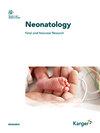新生儿鼻高流量插管期间脑氧合:SHINE随机试验的一项亚研究。
IF 3
3区 医学
Q1 PEDIATRICS
引用次数: 1
摘要
前言:鼻高流量(nHF)提高了新生儿插管成功的可能性在第一次尝试没有生理不稳定。nHF对脑氧合的影响尚不清楚。本研究的目的是比较接受nHF和接受标准护理的新生儿在气管插管期间的脑氧合情况。方法:一项新生儿气管插管期间nHF的多中心随机试验的亚研究。一部分婴儿接受近红外光谱(NIRS)监测。符合条件的婴儿在第一次插管时被随机分配到nHF或标准护理组。近红外光谱传感器提供连续的区域脑氧饱和度(rScO2)监测。录像整个过程,每隔2秒提取外周血氧饱和度和rScO2数据。主要终点是第一次插管时rScO2与基线的平均差异。次要结局包括平均rScO2和rScO2变化率。结果:共分析19例插管(11例nHF;8标准护理)。经后年龄中位数(四分位间距[IQR])为27(26.5-29)周,体重为828 (716- 1135)g。nHF组rScO2较基线的中位数变化为-1.5%(-5.3至0.0),标准治疗组为-9.4%(-19.6至-4.5)。与标准护理相比,接受nHF治疗的婴儿的rScO2下降更慢:rScO2的中位数(IQR)变化分别为-0.08(-0.13至0.00)% /秒和-0.36(-0.66至-0.22)% /秒。结论:在这个小的亚研究中,与标准护理相比,在插管期间接受nHF的新生儿的局部脑氧饱和度更稳定。本文章由计算机程序翻译,如有差异,请以英文原文为准。
Cerebral Oxygenation during Neonatal Intubation with Nasal High Flow: A Sub-Study of the SHINE Randomized Trial.
Introduction: Nasal high flow (nHF) improves the likelihood of successful neonatal intubation on the first attempt without physiological instability. The effect of nHF on cerebral oxygenation is unknown. The aim of this study was to compare cerebral oxygenation during endotracheal intubation in neonates receiving nHF and those receiving standard care. Methods: A sub-study of a multicentre randomized trial of nHF during neonatal endotracheal intubation. A subset of infants had near-infrared spectroscopy (NIRS) monitoring. Eligible infants were randomly assigned to nHF or standard care during the first intubation attempt. NIRS sensors provided continuous regional cerebral oxygen saturation (rScO2) monitoring. The procedure was video recorded, and peripheral oxygen saturation and rScO2 data were extracted at 2-second intervals. The primary outcome was the average difference in rScO2 from baseline during the first intubation attempt. Secondary outcomes included average rScO2 and rate of change of rScO2. Results: Nineteen intubations were analyzed (11 nHF; 8 standard care). Median (interquartile range [IQR]) postmenstrual age was 27 (26.5–29) weeks, and weight was 828 (716–1,135) g. Median change in rScO2 from baseline was −1.5% (−5.3 to 0.0) in the nHF group and −9.4% (−19.6 to −4.5) in the standard care group. rScO2 fell more slowly in infants managed with nHF compared with standard care: median (IQR) rScO2 change −0.08 (−0.13 to 0.00) % per second and −0.36 (−0.66 to −0.22) % per second, respectively. Conclusions: In this small sub-study, regional cerebral oxygen saturation was more stable in neonates who received nHF during intubation compared with standard care.
求助全文
通过发布文献求助,成功后即可免费获取论文全文。
去求助
来源期刊

Neonatology
医学-小儿科
CiteScore
0.60
自引率
4.00%
发文量
91
审稿时长
6-12 weeks
期刊介绍:
This highly respected and frequently cited journal is a prime source of information in the area of fetal and neonatal research. Original papers present research on all aspects of neonatology, fetal medicine and developmental biology. These papers encompass both basic science and clinical research including randomized trials, observational studies and epidemiology. Basic science research covers molecular biology, molecular genetics, physiology, biochemistry and pharmacology in fetal and neonatal life. In addition to the classic features the journal accepts papers for the sections Research Briefings and Sources of Neonatal Medicine (historical pieces). Papers reporting results of animal studies should be based upon hypotheses that relate to developmental processes or disorders in the human fetus or neonate.
 求助内容:
求助内容: 应助结果提醒方式:
应助结果提醒方式:


